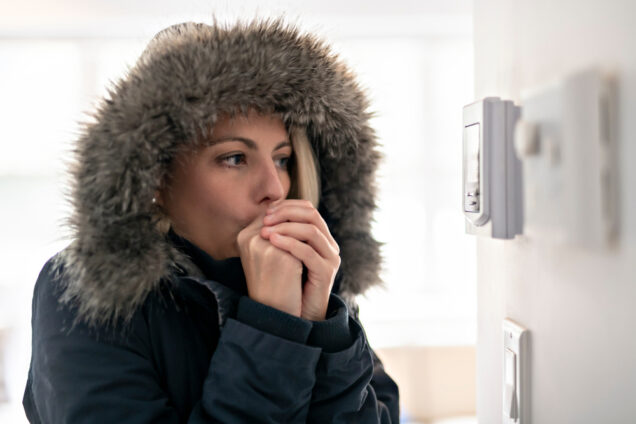In the chilly embrace of winter, a malfunctioning heat pump, gas furnace, or other type of heating equipment can quickly turn your cozy home into an uncomfortable icebox. Before you give us a call for heating repairs, there are several troubleshooting steps you can take to diagnose and, in some cases, rectify the issue.
Here is a guide from Mission Mechanical filled with steps that may get your HVAC system up and running again before you experience a cold house.
What Can Cause My Heat to Go Out?
When your heating system fails to deliver the comforting warmth you rely on, it can be a source of frustration and discomfort. A malfunction in your heating system can stem from various issues, ranging from simple operational glitches to more complex technical failures. Here are some common system malfunctions that could be at play when your heat doesn’t work.
- Ignition problems, such as a faulty ignition control board, dirty burners, or soot buildup on the flame sensor
- Malfunctioning blower motor or damaged fan blades
- Electronic issues such as malfunctioning circuit boards, electrical wiring problems, or sensor issues affecting system operation
- Pressure problems in boiler heating systems, such as low water pressure or high pressure causing safety shutdowns
- Blocked chimney exhaust flue or exhaust vents in gas heating systems
- Low refrigerant charge, stuck reversing valve, or defrost cycle problems in heat pumps
- Power outage
Troubleshooting Malfunctioning Heating Systems
Fortunately, when you experience heat pump, boiler, or furnace problems, there are some things you can try yourself that may restore heat quickly, without a call for heating repairs.
1. Check the Thermostat
The thermostat serves as the command center for your heating system. Start by ensuring the temperature setting is a few degrees above the current room temperature and that it is set to HEAT mode. Sometimes, a simple adjustment can solve the problem. If your manual, smart, or programmable thermostat relies on batteries, make sure they are not dead – if so, replace them.
2. Inspect the Circuit Breaker and Power Switch
A tripped circuit breaker can easily disrupt the power supply to your heating system. Head to the electrical panel and check if the breaker for your heating system is in the “on” position. If it has tripped, reset it and monitor to see if a heating cycle begins. If the breaker continues to trip, it may be indicative of an underlying electrical issue, warranting professional attention.
Also, check the power switch to your heating equipment. For forced air furnaces and boilers, check the switch on or near the unit; for heat pumps, check the switches for both the indoor and outdoor units – the switch to the outdoor unit is likely positioned on the exterior wall near where the refrigerant and power lines run into the home.
3. Examine the Air Filters
A dirty air filter can impede the airflow, reducing the efficiency of your heating system. Operating your system with dirty filters can cause it to overheat; once the unit reaches a certain temperature, the high limit safety switch will shut the furnace or air handler off. This safety feature is designed to protect the system and prevent fire hazards.
If your heat pump or furnace isn’t producing warm air, check the filter. Inspect pleated filters and fiberglass filters to see if they need to be replaced; if you have a dirty filter, replace it.
4. Verify the Pilot Light
For older gas furnace and boiler units, check the pilot light. If it’s out, relight it according to the directions in your owner’s manual. If the pilot light won’t stay lit or appears yellow instead of blue, it could be a sign of a more complex issue, and professional intervention may be necessary.
5. Examine the Gas Supply
Ensure that the gas supply to your heating system is uninterrupted. If you use propane or natural gas, verify that the supply valve is open on your gas pipe. If there are any suspicions of a gas leak, evacuate your home immediately and contact your gas provider and emergency services.
6. Inspect the Vents and Registers
Blocked or closed vents and registers can restrict the airflow, preventing your heating system from effectively warming your home. Closed vents may make it feel as though the heat pump or furnace isn’t heating your home even during a heating cycle. Ensure that all vents are open and unobstructed by furniture or other items.
Mission Mechanical Brings Back the Warmth
When your heating system leaves you out in the cold, these troubleshooting tips can be the first line of defense. If the heat remains elusive even after attempting the troubleshooting steps, it’s time to bring in the experts.
Contact Mission Mechanical for professional heating repair services in Indianapolis. Our team of professionals is equipped to diagnose and resolve even the most complex heating issues, ensuring your home is a haven of warmth during the heating season.




